
Nikolaus Barbie was a German officer of the SS and SD who worked in Vichy France during World War II. He became known as the "Butcher of Lyon" for having personally tortured prisoners—primarily Jews and members of the French Resistance—as the head of the Gestapo in Lyon. After the war, United States intelligence services employed him for his anti-communist efforts and aided his escape to Bolivia, where he advised the dictatorial regime on how to repress opposition through torture. In 1983, the United States apologised to France for the U.S. Counterintelligence Corps helping him escape to Bolivia, aiding Barbie's escape from an outstanding arrest warrant.
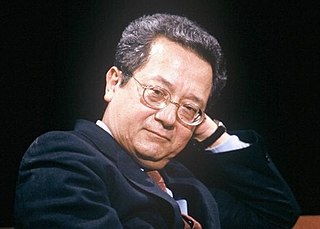
Jacques Vergès was a Siamese-born French lawyer and anti-colonial activist. Vergès began as a fighter in the French Resistance during World War II, under Charles de Gaulle's Free French forces. After becoming a lawyer, he became well known for his defense of FLN militants during the Algerian War of Independence. He was later involved in a number of controversial and high-profile legal cases, with a series of defendants charged with terrorism, serial murder, crimes against humanity, and war crimes. This includes Nazi officer Klaus Barbie "the Butcher of Lyon" in 1987, terrorist Carlos the Jackal in 1994, and former Khmer Rouge head of state Khieu Samphan in 2008. He also defended infamous Holocaust denier Roger Garaudy in 1998 as well as members of the Baader-Meinhof gang. As a result of taking on such clients, he garnered criticism from members of the public, including intellectuals Bernard-Henri Lévy and Alain Finkielkraut, political-activist Gerry Gable as well as Nazi hunter Serge Klarsfeld.

Jean Moulin was a French civil servant and resistant who succeeded in unifying the main networks of the French Resistance, a unique act in Europe. He served as the first President of the National Council of the Resistance during World War II from 27 May 1943 until his death less than two months later.

Hotel Terminus: The Life and Times of Klaus Barbie is a 1988 American documentary film by Marcel Ophuls about the life of Nazi war criminal Klaus Barbie. The film covers Barbie's relatively innocent childhood, his time with the Gestapo in Lyon, through to the forty years between the end of World War II and his eventual deportation from Bolivia to stand trial for crimes against humanity in France. The film explores a number of themes, including the nature of evil and the diffusion of responsibility in hierarchical situations.
Marcel Ophuls is a German-French documentary film maker and former actor, best known for his films The Sorrow and the Pity and Hôtel Terminus: The Life and Times of Klaus Barbie.

Serge Klarsfeld is a Romanian-born French activist and Nazi hunter known for documenting the Holocaust in order to establish the record and to enable the prosecution of war criminals. Since the 1960s, he has made notable efforts to commemorate the Jewish victims of German-occupied France and has been a supporter of Israel.

The International League Against Racism and Anti-Semitism—or Ligue internationale contre le racisme et l'antisémitisme (LICRA) in French—was established in 1927, and is opposed to intolerance, xenophobia and exclusion.
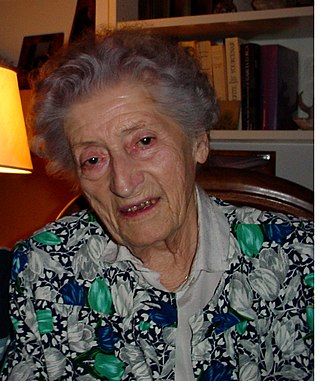
Lucie Samuel, born Lucie Bernard, and better known as Lucie Aubrac, was a French history teacher and member of the French Resistance during World War II. In 1938, she earned an agrégation of history, and in 1939 she married Raymond Samuel, who became known as Raymond Aubrac during the war.

Beate Auguste Klarsfeld is a Franco-German journalist and Nazi hunter who, along with her French husband, Serge, became famous for their investigation and documentation of numerous Nazi war criminals, including Kurt Lischka, Alois Brunner, Klaus Barbie, Ernst Ehlers and Kurt Asche.
A Nazi hunter is an individual who tracks down and gathers information on alleged former Nazis, or SS members, and Nazi collaborators who were involved in the Holocaust, typically for use at trial on charges of war crimes and crimes against humanity. Prominent Nazi hunters include Simon Wiesenthal, Tuviah Friedman, Serge Klarsfeld, Beate Klarsfeld, Ian Sayer, Yaron Svoray, Elliot Welles, and Efraim Zuroff.
René Hardy was a member of the French Resistance during World War II. Hardy was born in Mortrée, Orne. In spite of having rendered dedicated and valuable service as a member of the resistance group, Combat, he was still suspected of being instrumental in the arrest of Jean Moulin, General Charles Delestraint and other members of the resistance. Despite later being acquitted in 2 separate trials, those suspicions never went away.
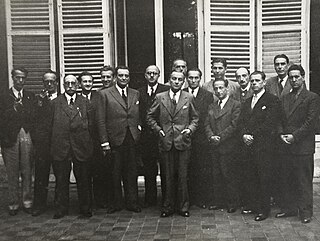
The National Council of the Resistance directed and coordinated the different movements of the French Resistance during World War II: the press, trade unions and political parties hostile to the Vichy regime, starting from mid-1943.
François Genoud was a noted Swiss financier and a principal benefactor of the Nazi diaspora through the ODESSA escape network and supporter of Middle Eastern militant groups during the post-World War II 20th century.

Ernesto "Che" Guevara was an Argentine Marxist revolutionary, physician, author, guerrilla leader, diplomat, and military theorist. A major figure of the Cuban Revolution, his stylized visage has become a ubiquitous countercultural symbol of rebellion and global insignia in popular culture.
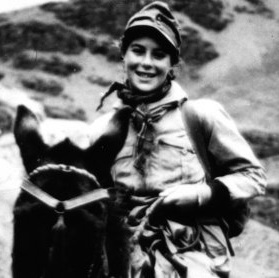
Monika Ertl was a German-Bolivian communist militant, guerrilla fighter and the daughter of Nazi propagandist Hans Ertl. She is most known for assassinating Colonel Roberto Quintanilla Pereira, the man responsible for chopping off Che Guevara's hands. This successful assassination earned her the title 'Che Guevara's avenger' in Germany. She continued to serve as a soldier in the National Liberation Army (ELN) resisting the Bolivian government, until she was slain by Bolivian security services in 1973. Her body was never returned to her family, and the site of her grave remains unknown.

The Centre d'histoire de la résistance et de la déportation is a museum in Lyon, France. Located on the former site of a French military health school and opened in 1992, it chronicles the French Resistance as well as Jewish deportation in World War II.

The Ñancahuazú Guerrilla or Ejército de Liberación Nacional de Bolivia was a group of mainly Bolivian and Cuban guerrillas led by the guerrilla leader Che Guevara which was active in the Cordillera Province of Bolivia from 1966 to 1967. The group established its base camp on a farm across the Ñancahuazú River, a seasonal tributary of the Rio Grande, 250 kilometers southwest of the city of Santa Cruz de la Sierra. The guerrillas intended to work as a foco, a point of armed resistance to be used as a first step to overthrow the Bolivian government and create a socialist state. The guerrillas defeated several Bolivian patrols before they were beaten and Guevara was captured and executed. Only five guerrillas managed to survive, including Harry Villegas, and fled to Chile.
Nazi Hunter: The Beate Klarsfeld Story is a 1986 American made-for-television biographical drama film, starring Farrah Fawcett in the title role. The film also stars Tom Conti, Geraldine Page and Catherine Allégret.
Ernst Misselwitz was an SS-Hauptscharführer who became head of the unit IV E of the RSHA – Reich Security Main Office of the Gestapo in occupied Paris, France, during World War II. In 1952 he was found guilty of having tortured French Resistance fighters. According to Serge Klarsfeld, French Intelligence employed Misselwitz after the war in helping them investigate Nazi war crimes and preparing court cases against wartime French collaborators.
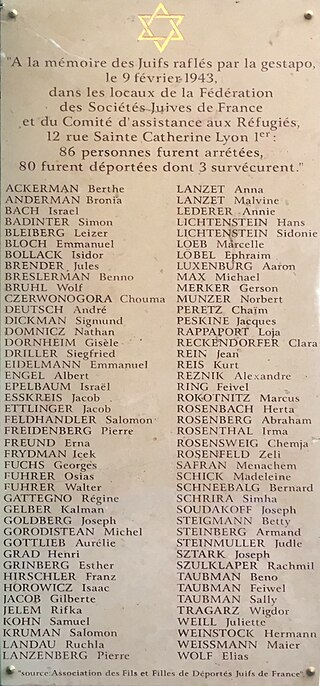
The rue Sainte-Catherine Roundup was a Nazi raid and mass arrest of Jews in Lyon's Sainte-Catherine street by the Gestapo. The raid, ordered and personally overseen by Klaus Barbie, took place on 9 February 1943 at the Fédération des sociétés juives de France, then located at the number 12 of this street. To catch as many people as possible, the Nazis not only chose the day the Federation normally gave free medical treatment and food to poor Jewish refugees, but they also set up a trap by forcing arrested Federation employees to encourage further people to come to the 12 rue Sainte Catherine.













